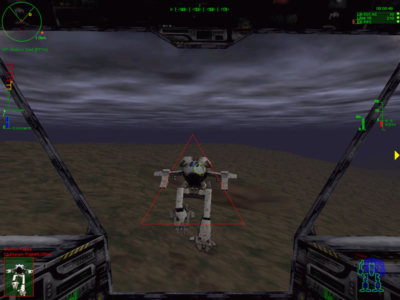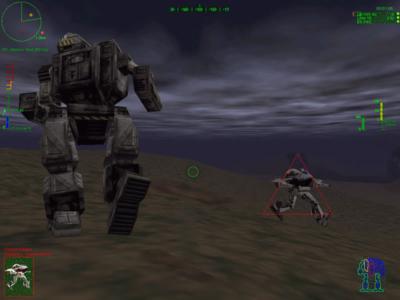
Mechwarrior 3
Written by: Stoo
Date posted: February 12, 2003
- Genre: Simulation
- Developed by: Zipper Interactive
- Published by: Microprose
- Year released: 1999
- Our score: 8
Tanks on legs: A good idea? Discuss. Pro: legs are better on rough terrain than wheels or tracks. Con: Being twenty metres tall makes you rather visible and tends to attract a lot of firepower in your direction – modern wisdom is to stay as low to the ground as possible. Still, the idea of ‘giant robots’ has gone down quite well in the world of gaming, as illustrated by the continued success of the Mechwarrior line. Even if Mechs aren’t actually robots, given that they’re not automated, but never mind.
Now, as you may know, there’s quite a lot of backstory to the Mechwarrior series, based as it is on a long-running tabletop wargame. I never really got into the details, but essentially the idea is that in the far future mankind has colonised most of the galaxy, and eventually split into a number of factions. The ‘Inner Sphere’ contains various peoples in the interior parts of the galaxy, while a number of militaristic and warlike clans rules the outer reaches. In Mechwarrior 2, a couple of clans were having a bit of a bash at each other, whilst Mech 2: Mercenaries dealt with an attempted clan invasion of the Inner Sphere. Now in Mechwarrior 3 it seems that one of the clans, Smoke Jaguar, has taken quite a pounding. Its remaining forces have retreated to a single planet, and you as commander of a small group of Inner Sphere mechs have been dispatched to finish the job.
So then, it’s time to clamber into the cockpit of your ridiculously heavily-armed war machine, cry havoc and let slip the mechs of war. It’s fair to say that Mech3 improved quite a lot on its predecessor. Whilst Mech2’s idea of terrain was a flat tabletop with a few polygon mountains scattered around, Mech3 gives us more rolling, varied countryside. It’s not quite as good as the luscious hills and valleys of modern games (or the ahead-of-its time Terra Nova), but good work nonetheless. Mech3 did add something new to the formula as well: bodies of water, adding a few options to your tactics (more on that later). Also there are some nice details such as villages and factories, complete with little panicking civllians. These help make the planet look like a real populated world, rather than a just set of big fields for Mechs to fight in. Perhaps slightly worrying though is that there’s no kind of penalty for kicking over innocent people’s houses. Surely we’re not supposed to be encouraged to go on a rampage of senseless destruction? Some of us don’t need much tempting…
The Mechs themselves are also looking quite good, not just in terms of graphical details but also in their motion. Whilst the big robots of previous games looked a bit stiff, in Mech3 they move more convincingly, swaying from side to side as they lumber around, or getting knocked off their feet by enemy fire and trying to clamber back up. So you do get a fairly convincing sense of these being real, 20 metre tall walking tanks, giant clanking engines of destruction.
As usual Mechs come in a wide range, from huge beweaponed behemoths, to small, fast and light models. They have weapons in the form of lasers, cannon, missiles and a few others. Success isn’t always a case of fielding the biggest Mech you can possibly find; personally I found the heaviest ones to be too damn slow and settled mostly for something in the mid-heavy range. Of course, you have plenty of options to tinker with the insides of your Mech. However, this system is almost too open-ended, to the point where it could alienate non-hardcore players. You see, a Mech’s chassis is essentially just a ‘box of weapons’. The external appearance might suggest that it’s some kind of long-ranged fire-support Mech, for example, with huge racks of missiles on the shoulders and maybe a couple of lasers on the arms as backup weapons. However you’re in no way required to select a weapons configuration that even vaguely resembles this. The only real restriction is that you must keep to limits of ‘hardpoints’ used (ie slots to mount an item) and overall mass. For example a medium pulse-laser weighs far less than a heavy autocannon plus ammo. This aside, you can stuff weapons and equipment wherever you like. This does maybe reduce the potential for ‘character’ that a certain class of Mech might have, when it can seem like each class is just a different sized gun-rack. To add further detail (or complication), you also have to arrange heat sinks and if you wish you can even fiddle with engine size and armour distribution. To be fair though it is wells worth trying out various combinations of all these factors. If you do manage to stick with it, all that tedious fiddling will be rewarded with some fairly kick-arse performance from your Mech on the battlefield.
Once you’ve done stacking up those lasers, you can then get stuck in. Combat requires a moderate amount of thinking alongside rampant blasting, as a few cunning tactics can help. A headlong charge against a 100-ton Mech armed with four heavy autocannon is likely to result in rapid death, so sneaking around his flanks and coming in from a different angle may help. Also, rapid firing of weapons causes heat to build up, resulting eventually in your Mech briefly shutting down. So, you either want to place your shots carefully, or try wading out waist-deep in a nearby body of water, to drastically speed up dissipation of heat. You usually have a couple of sqaudmates with you to help out; they never do anything really imaginative but do at least draw some enemy fire. A final point to take note of is your mobile field base, a trio of trucks which can repair you in battle and also hold your supply of weapons and spare parts. It should be fairly obvious that it’s a good idea to keep enemies away from the MFB.
The structure of the game meanwhile is just a linear series of missions, which is a bit of a shame after Mercenaries’ slightly more open system of letting you choose campaigns. The only real relation between one mission and the next is that what mechs and weaponry you have available depends on what you could salvage from previous battles. Also slightly annoying is that briefings get a bit over-long and tedious, as you’re essentially given the same information twice each time. Though the guy narrating (your commanding officer) does sound very much like Leonard Nimoy.
So then, some final thoughts on the Mech3. It improved all-round on what had gone before in the world of “tanks-on-legs” gaming, but didn’t add anything really new to the mix. So what we have then is a solid example of heavily-armed fun. It falls a bit short of what I would call a classic, but if the idea of huge walking war machines blasting away at each other has any appeal then you should definitely give this one a look.




 Posts
Posts